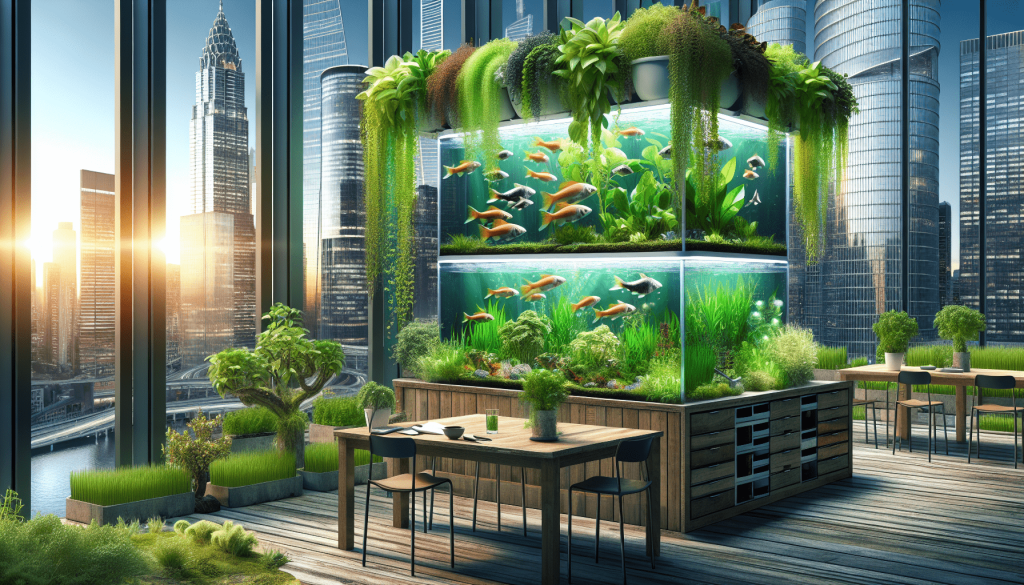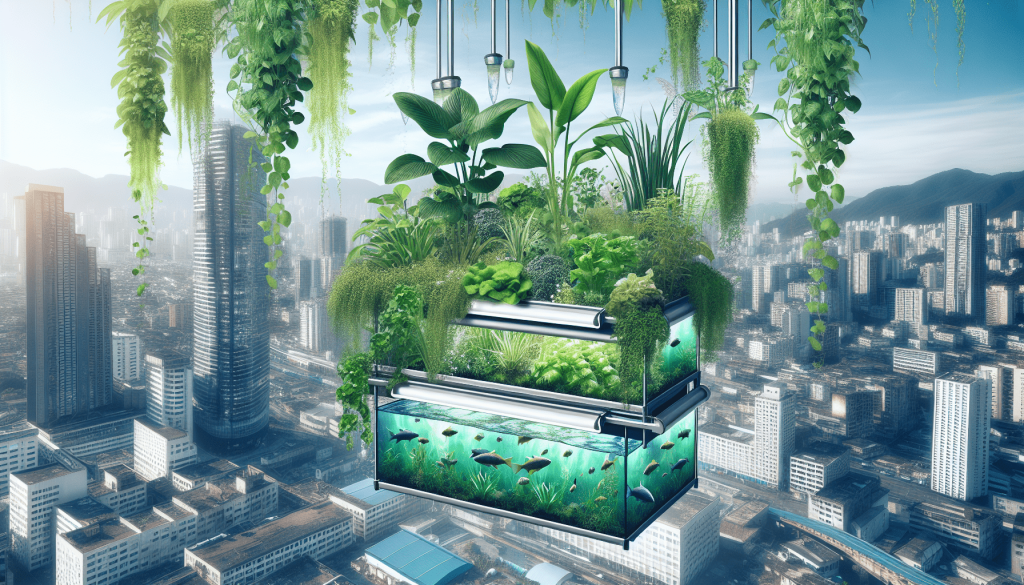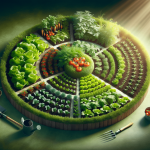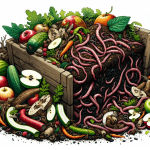This post may contain affiliate links. As an Amazon Associate, we may earn commissions from qualifying purchases.
Welcome to a journey through the potential of aquaponics in urban farming and sustainability. Imagine transforming city spaces into lush, green, productive landscapes where fish and plants thrive together in harmony. You will discover how this innovative system not only maximizes space but also conserves water, reduces waste, and yields fresh produce. Dive into a world where urban living and sustainable farming coexist beautifully, offering you a glimpse of a more sustainable and healthier future. Have you ever wondered how we can sustainably grow food within the confines of bustling cities while also minimizing our carbon footprint? Welcome to the fascinating world of aquaponics, a revolutionary approach that’s reshaping urban farming and sustainability.
What is Aquaponics?
Aquaponics is an innovative system that combines aquaculture (raising fish) and hydroponics (growing plants in water) to create a perfectly symbiotic environment. The fish waste provides an organic nutrient source for the plants, while the plants naturally filter the water, which is then recirculated back to the fish tanks.
How Does Aquaponics Work?
Think of it as a closed-loop ecosystem. Fish excrete ammonia, which can be toxic to them if it accumulates. However, nitrifying bacteria in the grow beds convert the ammonia into nitrates, a natural fertilizer. These nitrates are then absorbed by the plants as nutrients. The clean water is cycled back to the fish, creating a sustainable system with minimal waste.
The Potential of Aquaponics in Urban Farming
Urban landscapes are often synonymous with concrete jungles where green spaces are rare. However, the potential of aquaponics in urban farming is unparalleled. Let’s dive into the multiple facets that make aquaponics an ideal choice for city farming.
Space Efficiency
Urban farming often faces the constraint of limited space. Aquaponic systems can be set up vertically, utilizing towers or walls, thereby optimizing space usage. This means that even a small balcony can become a mini-farm.
Sustainability and Environmental Benefits
One of the most significant advantages of aquaponics is its sustainability. The system uses up to 90% less water compared to traditional soil-based farming. Additionally, it eliminates the need for chemical fertilizers and pesticides, promoting organic farming practices.
Reducing Urban Heat Islands
Urban areas tend to be hotter than their rural counterparts, a phenomenon known as the urban heat island effect. Incorporating aquaponics into urban settings can help mitigate this by increasing green spaces and improving air quality.

Components of an Aquaponic System
Understanding the basics of an aquaponic system can help you appreciate its potential. Let’s break down the key components.
Fish Tank
This is where the fish live and produce waste. The size of the fish tank can vary depending on the scale of your system. The choice of fish is also crucial; common types include tilapia, goldfish, and catfish.
Grow Beds
Grow beds are where the plants grow and the nitrification process occurs. These beds are usually filled with a growing medium like gravel or clay pellets that support the plants and house beneficial bacteria.
Water Pumps and Piping
Efficient water circulation is essential. Pumps are used to move water between the fish tank and grow beds, ensuring that plants receive nutrients and the fish get clean water.
Aeration Systems
Fish require oxygenated water to thrive. Aeration systems, such as air stones connected to air pumps, ensure that the dissolved oxygen levels in the water remain optimal.
Table: Basic Components of an Aquaponic System
| Component | Function |
|---|---|
| Fish Tank | Habitat for fish, source of nutrients |
| Grow Beds | Plant growth and nitrification |
| Water Pumps and Piping | Circulation of water between fish and plants |
| Aeration Systems | Maintains dissolved oxygen for fish |
Setting Up Your Own Aquaponic System
Creating your own aquaponic system may sound intimidating, but it can be straightforward and incredibly rewarding. Here’s a step-by-step guide to get you started.
Choose Your Location
Selecting the right location is crucial. Ensure that your chosen site receives sufficient natural light and has access to water and power sources. Indoor setups can use grow lights to supplement natural light.
Select the Right Fish and Plants
Choosing compatible fish and plants can make or break your aquaponic system. Common fish include tilapia for their hardiness, and leafy greens like lettuce and herbs, which thrive in aquaponic conditions.
Assemble Your Components
Start by setting up your fish tank and grow beds. Connect the water pumps and piping to facilitate water circulation. Introduce your fish and allow a few weeks for the nitrifying bacteria to establish themselves before adding plants.
Monitor and Maintain
Regular checks are essential for a thriving system. Monitor water pH, temperature, and ammonia levels to ensure both fish and plants remain healthy. Routine maintenance includes feeding fish, pruning plants, and cleaning filters.

The Science Behind Aquaponics
Aquaponics leverages several scientific principles, making it a robust and reliable farming method. Let’s delve into the scientific aspects that underpin this system.
The Nitrogen Cycle
The nitrogen cycle is central to aquaponics. Fish waste produces ammonia, which is then converted into nitrites and subsequently nitrates by beneficial bacteria in the grow bed. Nitrates are absorbed by plants, completing the cycle.
pH Levels
Maintaining an ideal pH range (generally between 6.8 and 7.2) is crucial for both fish and plant health. pH levels outside this range can harm fish and affect nutrient availability for plants.
Temperature Regulation
Both fish and plants have specific temperature requirements. Proper control of water temperature ensures optimal growth conditions. Heaters or coolers can be used to maintain stable temperatures.
Benefits of Aquaponics in Urban Farming
Aquaponics isn’t just a trendy buzzword—it offers tangible benefits that can transform urban farming. Here are some compelling reasons to consider adopting this system.
Water Conservation
As mentioned, aquaponics uses up to 90% less water than traditional farming. The closed-loop system recirculates water, making it highly efficient and ideal for water-scarce urban areas.
Local Food Production
Aquaponics enables local food production, reducing the need for long supply chains and lowering carbon footprints. Fresh produce can be grown and harvested right in the heart of the city.
Education and Community Engagement
Aquaponic systems can serve as educational tools, teaching urban dwellers about sustainable practices and ecology. They can also foster a sense of community through shared gardening projects.
Food Security
By producing fresh, organic food locally, aquaponics can play a role in enhancing food security in urban areas. It offers a reliable and self-sustaining food source that can be scaled up to meet community needs.
Challenges of Aquaponics in Urban Settings
While aquaponics has numerous benefits, it’s essential to be aware of the challenges that come with setting up and maintaining such a system in urban environments.
Initial Setup Costs
Setting up an aquaponic system can be capital-intensive, especially if you’re aiming for a large-scale operation. However, the long-term benefits and savings often outweigh the initial expenses.
Technical Knowledge
Aquaponics requires a foundational understanding of both aquaculture and hydroponics. Although many resources are available, a learning curve exists, which might be steep for beginners.
Regulatory Hurdles
Urban farming regulations can vary significantly between cities. You may need to navigate zoning laws, building codes, and permits, which can be time-consuming and complex.
Future Prospects of Aquaponics
The future potential of aquaponics in urban farming and sustainability is immense. Technological advancements and growing environmental awareness are likely to drive its adoption further.
Technological Innovations
Emerging technologies, such as IoT (Internet of Things) and AI (Artificial Intelligence), are making it easier to monitor and manage aquaponic systems. Smart sensors can track water quality, automate feeding, and provide real-time data to optimize operations.
Integration with Other Urban Farming Techniques
Aquaponics can be integrated with other sustainable farming practices, such as vertical farming and rooftop gardens. This synergy can create highly productive and sustainable urban agriculture systems.
Policy Support and Incentives
As governments and organizations recognize the benefits of sustainable urban farming, policy support and incentives are likely to increase. Grants, subsidies, and tax benefits can significantly lower the barriers to entry.
Success Stories and Case Studies
Numerous success stories from around the world highlight the efficacy of aquaponics in urban settings. Let’s look at some:
Brooklyn Grange, New York
Brooklyn Grange operates the world’s largest rooftop soil farm but also incorporates aquaponic systems. They have created a vibrant urban farm that provides fresh produce to local communities while promoting sustainable practices.
Aqualife Farms, Florida
Aqualife Farms has successfully implemented a large-scale aquaponic system, producing a variety of vegetables and herbs. They also offer educational programs to teach others about this innovative farming method.
GrowUp Urban Farms, London
GrowUp Urban Farms in London uses aquaponics to produce fresh, leafy greens and herbs. Their system is located in an industrial warehouse, demonstrating the adaptability of aquaponics to different urban environments.
Getting Involved: How Can You Contribute?
Whether you’re a city dweller with limited space or someone looking to make a more significant impact, there are various ways to get involved in the aquaponics movement.
Start Small
You don’t need a large setup to start. A small system with a fish tank and a few grow beds can be a fun and rewarding way to dip your toes into aquaponics.
Join a Community
Many urban areas have community gardens and aquaponic clubs. Joining these groups can provide valuable resources, support, and networking opportunities.
Advocate and Educate
Raising awareness about the benefits of aquaponics can help foster a supportive environment for its adoption. Engage with local schools, community centers, and policymakers to advocate for sustainable farming practices.
Final Thoughts
The potential of aquaponics in urban farming and sustainability is vast and exciting. By combining the best of aquaculture and hydroponics, aquaponics offers a sustainable, efficient, and scalable solution for growing food in urban settings. Whether you’re an individual looking to grow your food or part of a larger movement aiming to make cities greener and more self-sufficient, aquaponics presents a compelling option.
Dive into the world of aquaponics today, and you’ll be contributing to a more sustainable and resilient urban environment for tomorrow.








